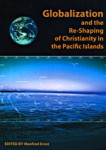 On July 13th of this year, the Fijian Vice-President participated at the Pacific Theological College in the official launch of a collective book edited by Manfred Ernst, Globalization and the Re-shaping of Christianity in the Pacific Islands, dealing with the contemporary changes of Christianity in Oceania: Mormon and Adventist Churches taking root, declining Historical Protestant Churches and rapidly growing Evangelicals and Pentecostals.
On July 13th of this year, the Fijian Vice-President participated at the Pacific Theological College in the official launch of a collective book edited by Manfred Ernst, Globalization and the Re-shaping of Christianity in the Pacific Islands, dealing with the contemporary changes of Christianity in Oceania: Mormon and Adventist Churches taking root, declining Historical Protestant Churches and rapidly growing Evangelicals and Pentecostals.
In 1994, M. Ernst published a first study, Winds of Change, a project founded by the Pacific Conference of Churches that gathers Catholic, Historical Protestant and Anglican Churches in Oceania. The heads of these churches wanted to get information and analysis in order to understand and foil what they saw as an invasion of “foreign” (and more specifically American) Churches and beliefs. Despite some arguable points (notably the supposedly impossible conciliation between “community” local Christian cultures and movements described as “individualists”), Winds of Change became a major reference for those interested in the study of contemporary Christianity in Oceania. The very expected book launched in July will certainly be an even more precious source of information and analysis. Ten years after, it draws up a new inventory, once again with the support of the Pacific Conference of Churches. During these ten years, the “new” churches have deeply taken root in the Oceania religious landscape and it has become more and more difficult to think that they still have “nothing to do” with the local cultures and societies. So we need to understand in what extent they go with and/or contribute to social and cultural changes experienced by the Oceania Islands, how they articulate local specificities and a religious globalisation. The heads of the Historical Churches now understand that these “new” Churches compensate for many of their own deficiencies: too hierarchical structures of authority controlled by the old generation, small part given to the youth in the making of decision, an obsolete rigorism left by the missionaries (dresses, music, role of women), a discourse focused on the inherited belonging to an ethnic-cultural community rather than on individual needs, etc. To dream on the “good old time” coming back is vain, the time when these churches organised the religious and social life of Oceania populations and the urgent task is now to think on the main challenge of the next years: the modalities of religious pluralism. The second part of the book is made of detailed case studies of the religious landscape in 14 Pacific countries, Gwendoline Malogne-Fer and I wrote the chapter on French Polynesia. The book can be notably purchased on the website of the USP (University of the South Pacific) or with an order form.